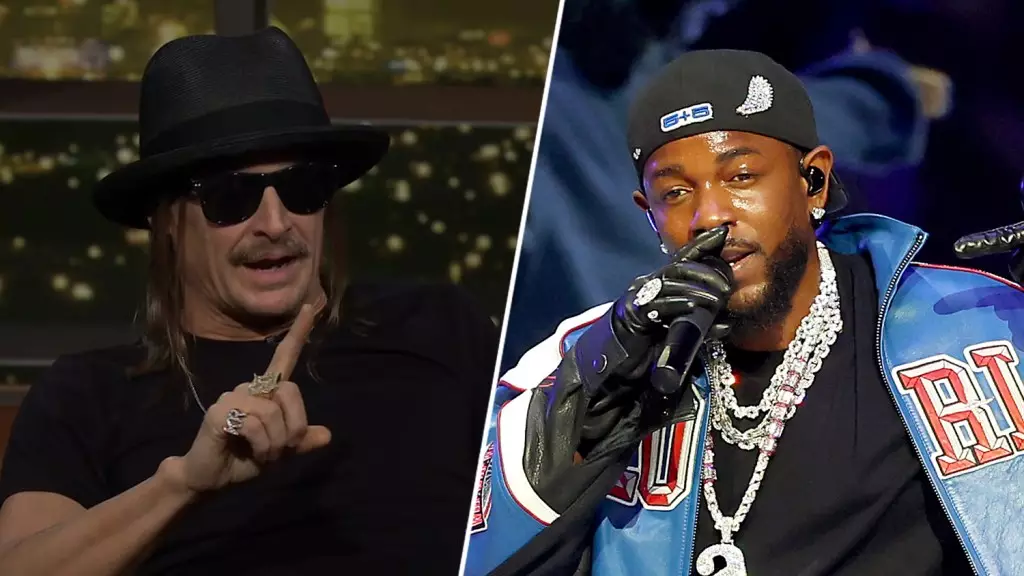Kendrick Lamar’s Super Bowl halftime performance undeniably sparked a variety of reactions from viewers across the spectrum, but the response from Kid Rock, a musician known for his controversial statements, overshadowed the event itself. The contrast between Lamar’s artistic expression and Rock’s critical remarks illustrates a broader conversation about cultural perception, representation, and artistic authenticity in a world often polarized by race and musical genres. Rock’s comments reflect an ongoing debate regarding who controls the narrative in hip-hop and how that narrative should be presented on mainstream platforms like the Super Bowl.
The term DEI—Diversity, Equity, and Inclusion—has been a hot topic in contemporary discussions around representation in the entertainment industry, particularly within the realm of the NFL. Rock’s insistence that Lamar’s performance was the “epitome of DEI blowing up” touches on the complexities surrounding tokenism versus genuine representation. While he critiques the absence of white performers during Lamar’s set, his perspective fails to recognize the intentionality behind Lamar’s representation of Black culture and artistry. It’s essential to contextualize these performances as part of a broader narrative where Black musicians grapple with their identity in a predominantly commercial and often exclusionary industry.
Rock’s assertion that he “understands the culture” reflects a common sentiment among artists from different backgrounds attempting to navigate the nuances of hip-hop. However, his framing of Kendrick’s set as a rejection of inclusivity strips the performance of its rich cultural significance. Lamar’s act, far from being an exclusionary gesture, likely served as a powerful affirmation of Black artistry amidst a landscape that has historically marginalized it. The intricacies of cultural appreciation versus appropriation come into play here, highlighting the challenges faced by artists who seek to maintain their authenticity while engaging with mainstream audiences.
What is particularly noteworthy is Rock’s call for Jay-Z and Kendrick Lamar to send a “thank you” to Colin Kaepernick. This statement, while amusing on the surface, simplifies a deeply complicated history of protest and representation in America. Kaepernick’s kneeling during the national anthem sparked a national conversation that transformed perceptions of identity and protest in sports. Rock’s acknowledgment of this connection indicates an awareness of how political and social movements influence artistic spaces, yet it simultaneously highlights his tendency to reduce complex social issues to digestible commentary.
Rock’s reaction suggests a misunderstanding of artistic freedom through the lens of cultural celebration. By emphasizing that Lamar’s performance lacked “white people,” he implies that any form of exclusivity detracts from the performance’s value. Yet, the purpose of Lamar’s performance could well be understood as a celebration of Black narratives and experiences, raising questions about who has the right to define what inclusivity looks like in art. This invites a reflection on how the music industry has often sidelined marginalized voices and the necessity of spaces that allow those voices to thrive unfiltered.
Kendrick Lamar’s halftime show served as a platform for bold artistic statements, challenging both societal norms and the expectations of mainstream entertainment. The juxtaposition of his performance with Kid Rock’s perspective highlights the differing viewpoints surrounding race, identity, and representation in hip-hop and beyond. As listeners and viewers, it is our responsibility to critically assess these discourses, acknowledging the rich history and culture they emerge from and recognizing the complexities that these conversations entail.
In closing, Rock’s reaction, while revealing his own biases and misunderstandings, opens up a necessary dialogue about representation in the arts. Kendrick Lamar’s unapologetic celebration of Black culture should not be diminished by criticisms that overlook the significance of his message. At the intersection of culture and performance, we must strive for a deeper understanding that appreciates the diversity inherent in artistic expression.

